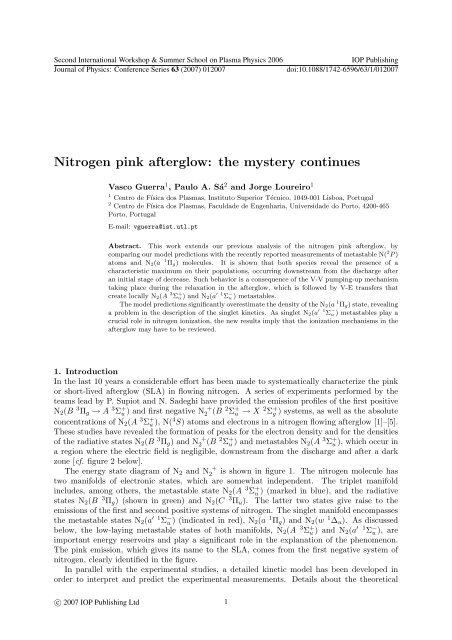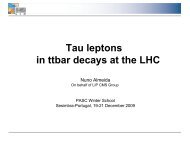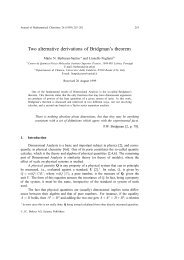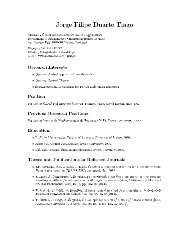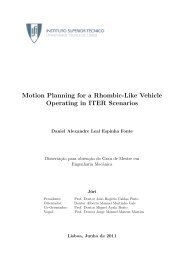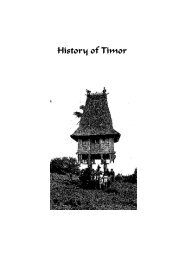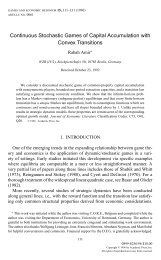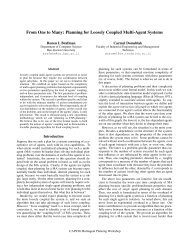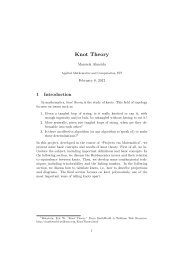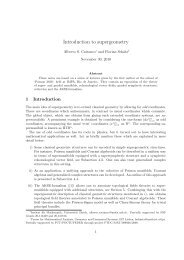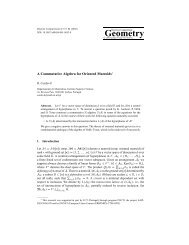Nitrogen pink afterglow: the mystery continues
Nitrogen pink afterglow: the mystery continues
Nitrogen pink afterglow: the mystery continues
- No tags were found...
Create successful ePaper yourself
Turn your PDF publications into a flip-book with our unique Google optimized e-Paper software.
Second International Workshop & Summer School on Plasma Physics 2006Journal of Physics: Conference Series 63 (2007) 012007IOP Publishingdoi:10.1088/1742-6596/63/1/012007<strong>Nitrogen</strong> <strong>pink</strong> <strong>afterglow</strong>: <strong>the</strong> <strong>mystery</strong> <strong>continues</strong>Vasco Guerra 1 , Paulo A. Sá 2 and Jorge Loureiro 11 Centro de Física dos Plasmas, Instituto Superior Técnico, 1049-001 Lisboa, Portugal2 Centro de Física dos Plasmas, Faculdade de Engenharia, Universidade do Porto, 4200-465Porto, PortugalE-mail: vguerra@ist.utl.ptAbstract. This work extends our previous analysis of <strong>the</strong> nitrogen <strong>pink</strong> <strong>afterglow</strong>, bycomparing our model predictions with <strong>the</strong> recently reported measurements of metastable N( 2 P )atoms and N 2(a 1 Π g) molecules. It is shown that both species reveal <strong>the</strong> presence of acharacteristic maximum on <strong>the</strong>ir populations, occurring downstream from <strong>the</strong> discharge afteran initial stage of decrease. Such behavior is a consequence of <strong>the</strong> V-V pumping-up mechanismtaking place during <strong>the</strong> relaxation in <strong>the</strong> <strong>afterglow</strong>, which is followed by V-E transfers thatcreate locally N 2(A 3 Σ + u ) and N 2(a ′ 1 Σ − u ) metastables.The model predictions significantly overestimate <strong>the</strong> density of <strong>the</strong> N 2(a 1 Π g) state, revealinga problem in <strong>the</strong> description of <strong>the</strong> singlet kinetics. As singlet N 2(a ′ 1 Σ − u ) metastables play acrucial role in nitrogen ionization, <strong>the</strong> new results imply that <strong>the</strong> ionization mechanisms in <strong>the</strong><strong>afterglow</strong> may have to be reviewed.1. IntroductionIn <strong>the</strong> last 10 years a considerable effort has been made to systematically characterize <strong>the</strong> <strong>pink</strong>or short-lived <strong>afterglow</strong> (SLA) in flowing nitrogen. A series of experiments performed by <strong>the</strong>teams lead by P. Supiot and N. Sadeghi have provided <strong>the</strong> emission profiles of <strong>the</strong> first positiveN 2 (B 3 Π g → A 3 Σ + u ) and first negative N +2 (B 2 Σ + u → X 2 Σ + g ) systems, as well as <strong>the</strong> absoluteconcentrations of N 2 (A 3 Σ + u ), N( 4 S) atoms and electrons in a nitrogen flowing <strong>afterglow</strong> [1]–[5].These studies have revealed <strong>the</strong> formation of peaks for <strong>the</strong> electron density and for <strong>the</strong> densitiesof <strong>the</strong> radiative states N 2 (B 3 Π g ) and N 2 + (B 2 Σ + u ) and metastables N 2 (A 3 Σ + u ), which occur ina region where <strong>the</strong> electric field is negligible, downstream from <strong>the</strong> discharge and after a darkzone [cf. figure 2 below].The energy state diagram of N 2 and N 2 + is shown in figure 1. The nitrogen molecule hastwo manifolds of electronic states, which are somewhat independent. The triplet manifoldincludes, among o<strong>the</strong>rs, <strong>the</strong> metastable state N 2 (A 3 Σ + u ) (marked in blue), and <strong>the</strong> radiativestates N 2 (B 3 Π g ) (shown in green) and N 2 (C 3 Π u ). The latter two states give raise to <strong>the</strong>emissions of <strong>the</strong> first and second positive systems of nitrogen. The singlet manifold encompasses<strong>the</strong> metastable states N 2 (a ′ 1 Σ − u ) (indicated in red), N 2 (a 1 Π g ) and N 2 (w 1 ∆ u ). As discussedbelow, <strong>the</strong> low-laying metastable states of both manifolds, N 2 (A 3 Σ + u ) and N 2 (a ′ 1 Σ − u ), areimportant energy reservoirs and play a significant role in <strong>the</strong> explanation of <strong>the</strong> phenomenon.The <strong>pink</strong> emission, which gives its name to <strong>the</strong> SLA, comes from <strong>the</strong> first negative system ofnitrogen, clearly identified in <strong>the</strong> figure.In parallel with <strong>the</strong> experimental studies, a detailed kinetic model has been developed inorder to interpret and predict <strong>the</strong> experimental measurements. Details about <strong>the</strong> <strong>the</strong>oreticalc○ 2007 IOP Publishing Ltd 1
Second International Workshop & Summer School on Plasma Physics 2006Journal of Physics: Conference Series 63 (2007) 012007IOP Publishingdoi:10.1088/1742-6596/63/1/012007Potencial energy (eV)Internuclear distance (A)Figure 1. Energy state diagram of N 2 and N 2 + . The <strong>pink</strong> emission corresponds to<strong>the</strong> transition N 2 + (B 2 Σ + u → X 2 Σ + g ).model can be found in [6]–[8]. The <strong>the</strong>oretical investigation allowed to solve <strong>the</strong> puzzle to abig extent, by unambiguously showing that vibrationally excited molecules in high v levels arein <strong>the</strong> origin of <strong>the</strong> peaks observed in <strong>the</strong> flowing <strong>afterglow</strong> for <strong>the</strong> concentrations of variousspecies, as a consequence of <strong>the</strong> so-called V-V pumping-up mechanism. As a matter of fact, <strong>the</strong>anharmonicity of <strong>the</strong> potential curve of N 2 (X 1 Σ + g ) implies that <strong>the</strong> energy difference betweenneighboring vibrational levels decreases from <strong>the</strong> bottom to <strong>the</strong> top of <strong>the</strong> vibrational ladder.As a consequence, <strong>the</strong> vibration-vibration (V-V) reactionsN 2 (X, v) + N 2 (X, w) ↔ N 2 (X, v − 1) + N 2 (X, w + 1) (1)are not exactly resonant and, for v < w, have a larger coefficient for <strong>the</strong> forward process. Thisoriginates a climbing in <strong>the</strong> vibrational ladder during <strong>the</strong> relaxation process in <strong>the</strong> <strong>afterglow</strong>[9]. The highly vibrationally excited dark states N 2 (X 1 Σ + g , v) formed in this way subsequentlytransfer <strong>the</strong>ir energy to electronically excited states through vibration-electronic (V-E) energytransfer processes that can be mediated by heavy-particles (such as N( 4 S) atoms) and/orelectrons [8, 10, 11]. The key point is <strong>the</strong> formation of N 2 (A 3 Σ + u ) and N 2 (a ′ 1 Σ − u ) locallyin <strong>the</strong> <strong>afterglow</strong>, which are <strong>the</strong>n involved in a series of reactions of formation of o<strong>the</strong>r species[7, 8].In this work we extend our previous results to <strong>the</strong> analysis of <strong>the</strong> recent measurementsof <strong>the</strong> absolute concentrations of N( 2 P ) and N 2 (a 1 Π g ) metastables in <strong>the</strong> nitrogen <strong>afterglow</strong>2
Second International Workshop & Summer School on Plasma Physics 2006Journal of Physics: Conference Series 63 (2007) 012007IOP Publishingdoi:10.1088/1742-6596/63/1/012007Microwave cavity(433 MHz)Dark zoneN 2DischargeShort Lived AfterglowFigure 2. Schematic description of <strong>the</strong> nitrogen flowing <strong>afterglow</strong> under investigation,showing <strong>the</strong> active discharge, <strong>the</strong> dark zone and <strong>the</strong> SLA.reported in[12], which were obtained using a complex technique based on emission spectroscopy.The system under analysis is <strong>the</strong> <strong>afterglow</strong> of a surface-wave discharge operating at frequencyω/2π = 433 MHz, pressure p = 3.3 Torr, in a Pyrex tube of inner radius R = 1.9 cm, asschematically depicted in figure 2. The electron density at <strong>the</strong> end of <strong>the</strong> discharge/beginningof <strong>the</strong> post-discharge is estimated to be n e (0) = 3 × 10 10 cm −3 [1], a value slightly larger than<strong>the</strong> critical value for a surface-wave propagating at 433 MHz, n ec ≃ 1.3 × 10 10 cm −3 , and<strong>the</strong> value of <strong>the</strong> gas temperature in <strong>the</strong> discharge is approximately 1000 K. These <strong>afterglow</strong>conditions correspond to <strong>the</strong> experimental characterization from [1]–[5], which allows a detailedcomparison between <strong>the</strong> model predictions and <strong>the</strong> experimental measurements. For <strong>the</strong>seconditions, <strong>the</strong> calculated effective field in <strong>the</strong> discharge is E e /N = 4.6 × 10 −16 V.cm 2 and <strong>the</strong>vibrational temperature of ground-state molecules, T V , is about 6200 K. Take notice that <strong>the</strong>critical density for surface-wave propagation is calculated for <strong>the</strong> homogeneous collisionless casefrom n ec = n c (1 + ε d ), where n c = mε 0 ω 2 /e 2 is <strong>the</strong> cutoff plasma density, m and e denoting <strong>the</strong>electron mass and charge, respectively, and ε d is <strong>the</strong> relative permittivity of Pyrex [13]. However,electron densities below n ec have been experimentally observed in surface wave discharges, as aconsequence of <strong>the</strong> effects of collisions and of <strong>the</strong> inhomogeneity in <strong>the</strong> spatial distribution of<strong>the</strong> plasma density [14].2. Kinetic modelThe Kinetic model is described in detail in [7]. It comprises two modules, one describing <strong>the</strong>stationary discharge in <strong>the</strong> alternating field and ano<strong>the</strong>r one <strong>the</strong> <strong>afterglow</strong>. The first moduleallows <strong>the</strong> calculation of <strong>the</strong> electron energy distribution function, <strong>the</strong> vibrational distributionfunction (VDF) of N 2 (X 1 Σ + g , v) molecules, <strong>the</strong> concentrations of N 2 excited states A 3 Σ + u ,B 3 Π g , B ′ 3 Σ − u , C 3 Π u , a ′ 1 Σ − u , a 1 Π g , w 1 ∆ u , of N( 4 S) ground-state and excited 2 D and2 P atoms, as well as of N 2 + (X 2 Σ + g , B 2 Σ + u ) and N 4 + ions. The system of coupled equationsincludes <strong>the</strong> stationary homogeneous electron Boltzmann equation, <strong>the</strong> rate balance equationsfor <strong>the</strong> neutral and charged heavy-particles and <strong>the</strong> quasi-neutrality condition. The maintenancehigh frequency field is self-consistently determined by requiring an exact equality between <strong>the</strong>total rate of ionization and <strong>the</strong> total rate of electron losses. A list with all <strong>the</strong> reactions consideredin <strong>the</strong> model, toge<strong>the</strong>r with <strong>the</strong>ir corresponding rate coefficients, can be found in [7].3
Second International Workshop & Summer School on Plasma Physics 2006Journal of Physics: Conference Series 63 (2007) 012007IOP Publishingdoi:10.1088/1742-6596/63/1/012007Once <strong>the</strong> steady-state discharge concentrations and distributions have been obtained, <strong>the</strong>relaxation model for <strong>the</strong> post-discharge is basically <strong>the</strong> same as in <strong>the</strong> discharge, by consideringtime-dependent equations with zero electric field and <strong>the</strong> discharge calculated values as initialconditions for <strong>the</strong> <strong>afterglow</strong>. It is worth remarking that <strong>the</strong> treatment is time-dependent andspace-homogeneous (0-D). As <strong>the</strong> experimental data refers to space profiles, in order to compare<strong>the</strong> model predictions with <strong>the</strong> experimental measurements it is necessary to translate <strong>afterglow</strong>time into <strong>afterglow</strong> distance by means of <strong>the</strong> mass flow and <strong>the</strong> experimental gas temperatureprofile in <strong>the</strong> post-discharge.As largely discussed in [6]–[8], <strong>the</strong> critical issue to understand <strong>the</strong> nitrogen <strong>afterglow</strong> is <strong>the</strong>local formation of <strong>the</strong> metastable states N 2 (A 3 Σ + u ) and N 2 (a ′ 1 Σ − u ), in V-E transfers that follow<strong>the</strong> V-V pumping-up process. Assuming <strong>the</strong>se transfers to be induced by heavy-particles, onepossible mechanism is via reactions [6]–[8]N 2 (X, v ≥ 39) + N( 4 S) → N 2 (A) + N( 2 D) (2)N 2 (X, v ≥ 38) + N( 4 S) → N 2 (a ′ ) + N( 4 S) . (3)Once <strong>the</strong>se two metastable states are created, o<strong>the</strong>r species are readily created. Thus, N 2 (B 3 Π g )is formed throughN 2 (A) + N 2 (X, 5 ≤ v ≤ 14) → N 2 (B) + N 2 (X, v = 0) . (4)On <strong>the</strong> o<strong>the</strong>r hand, electrons and N +2 (X 2 Σ + g ) ions are formed by <strong>the</strong> Penning mechanismsandFinally, N +2 (B 2 Σ + u ) ions are formed byN 2 (A) + N 2 (a ′ ) → N +2 + N 2 + e (5)N 2 (a ′ ) + N 2 (a ′ ) → N +2 + N 2 + e . (6)N 2 (X, v ≥ 12) + N +2 (X) → N +2 (B) + N 2(X) . (7)This set of reactions provides a satisfactory explanation for <strong>the</strong> concentrations and profiles ofelectrons and excited states N 2 (A 3 Σ + u , B 3 Π g ) and N 2 + (B 2 Σ + u ) [6].The possible role of electron mediated V-E energy transfers was verified in [7] by assuming,as an alternative to reactions (2) and (3), that electronically excited states can be created byreactionse + N 2 (X, v ≥ 25) → e + N 2 (A) (8)ande + N 2 (X, v ≥ 38) → e + N 2 (a ′ ) , (9)and will not be discussed here. Never<strong>the</strong>less, it is worth noting that <strong>the</strong> recent experimentsreported in [10, 11] show beyond doubt that electron mediated V-E processes occur in CO, ationization degrees as low as 10 −9 –10 −7 . For this reason we suggested in [6] and confirmed in[7] that resonant electron mediated vibration-electronic V-E energy transfers may contributeas well to <strong>the</strong> formation of electronically excited states in <strong>the</strong> nitrogen <strong>afterglow</strong>. In fact, <strong>the</strong>reactions of associative or Penning ionization that occur in <strong>the</strong> post-discharge can create lowenergy electrons able to participate nearly isoenergetic reactions. Moreover, <strong>the</strong> depopulationof high vibrational levels N 2 (X 1 Σ + g , v) by electron superelastic collisions may substantiallyincrease <strong>the</strong> energy of <strong>the</strong>se electrons.4
Second International Workshop & Summer School on Plasma Physics 2006Journal of Physics: Conference Series 63 (2007) 012007IOP Publishingdoi:10.1088/1742-6596/63/1/0120073. Results and discussionFigure 3 shows <strong>the</strong> vibrational distribution function (VDF) of N 2 (X 1 Σ + g , v) molecules calculatedat different <strong>afterglow</strong> times between 0 and 1 s, clearly illustrating <strong>the</strong> V-V pumping of <strong>the</strong> highv levels. The tail of <strong>the</strong> VDF passes through a maximum for <strong>afterglow</strong> times of <strong>the</strong> order of 10 −2s, which starts to exist for levels v ≥ 25 and is very pronounced for v ≥ 35. The open circles are<strong>the</strong> Raman scattering measurements in <strong>the</strong> <strong>afterglow</strong> of a surface-wave discharge correspondingto <strong>the</strong> conditions of <strong>the</strong> calculations, for an <strong>afterglow</strong> time t ∼ 5 × 10 −2 s [15]. The blackcircle is <strong>the</strong> cavity ringdown spectroscopy measurement of <strong>the</strong> population of level v = 18 ina DC discharge at p = 2.3 Torr and I = 100 mA [16], which is, to our knowledge, <strong>the</strong> onlymeasurement available for a relatively high vibrational level. Notice that <strong>the</strong> presence of <strong>the</strong>sedark high vibrational levels in <strong>the</strong> SLA, which are not effectively populated in <strong>the</strong> discharge,makes <strong>the</strong>m available to participate in chemical V-E reactions in <strong>the</strong> <strong>afterglow</strong>. They are thus<strong>the</strong> energy carriers responsible for most of <strong>the</strong> effects observed in <strong>the</strong> <strong>afterglow</strong>, including <strong>the</strong>raise in <strong>the</strong> populations of several species. The contribution of ground-state atoms N( 4 S) to <strong>the</strong>formation of <strong>the</strong> SLA via three-body recombination has also been suggested in <strong>the</strong> literature[1, 17]. However, it seems clear that this mechanism, although with a possible contribution to<strong>the</strong> absolute concentrations of <strong>the</strong> different species experimentally found, cannot by itself justify<strong>the</strong> overall behaviour of <strong>the</strong> nitrogen <strong>afterglow</strong> [8].10 -110 -2[N 2(X,v)]/[N 2]10 0 F10 -3ED10 -4ABC10 -50 10 20 30 40Vibrational quantum number vFigure 3. VDF of N 2 (X 1 Σ + g , v) molecules in <strong>the</strong> nitrogen <strong>afterglow</strong> of a ω/2π = 433MHz discharge at p = 3.3 Torr, in a cylindrical tube of inner radius R = 1.9 cm,for which E e /N = 4.6 × 10 −16 V.cm 2 and T V ≃ 6200 K, at different instants in <strong>the</strong><strong>afterglow</strong>: t = 0 (A); t = 10 −4 s (B); t = 10 −3 s (C); t = 10 −2 s (D); t = 10 −1 s (E);and t = 1 s (F). Experimental data from [15] (◦ ) and [16] (• ) (see text).5
Second International Workshop & Summer School on Plasma Physics 2006Journal of Physics: Conference Series 63 (2007) 012007IOP Publishingdoi:10.1088/1742-6596/63/1/012007The excellent agreement obtained between our model calculations and <strong>the</strong> experimentalresults for <strong>the</strong> population of <strong>the</strong> N 2 (A 3 Σ + u ) is shown in figures 4. The <strong>the</strong>oretical resultscorrespond to <strong>the</strong> kinetic scheme delineated above. This agreement extends to <strong>the</strong> populationsof states N 2 (B 3 Π g ) and N 2 + (B 2 Σ + u ), to ground state N( 4 S) atoms and to <strong>the</strong> electron density[6]–[8].The comparison of fur<strong>the</strong>r model predictions with <strong>the</strong> recently measured populations of N( 2 P )and N 2 (a 1 Π g ) constitutes an important test to verify <strong>the</strong> validity of <strong>the</strong> adopted kinetic scheme.10 -4 Afterglow time (s)10 -5[N 2(A)]/N10 -610 -710 -810 -5 10 -4 10 -3 10 -2 10 -1 10 0Figure 4. Measured [4] and calculated absolute population of N 2 (A 3 Σ + u ) metastablesalong <strong>the</strong> <strong>afterglow</strong>, for <strong>the</strong> conditions of figure 3.The kinetics of N( 2 P ) metastables is strongly coupled to <strong>the</strong> kinetics of ground-state N( 4 S)atoms and triplet N 2 (A 3 Σ + u ) molecules. In fact, in a nitrogen post-discharge N( 2 P ) atoms areessentially formed and destroyed in reactions involving <strong>the</strong>se two species [6, 7], namelyandN 2 (A) + N( 4 S) → N 2 (X, 6 ≤ v ≤ 9) + N( 2 P ) (10)N 2 (X, v ≥ 10) + N( 2 P ) → N 2 (A) + N( 4 S) . (11)Figure 5 reveals that <strong>the</strong> excellent agreement between <strong>the</strong> model predictions and <strong>the</strong>measurements previously found for <strong>the</strong> populations of N 2 (A 3 Σ + u ), N 2 (B 3 Π g ) and N( 4 S) during<strong>the</strong> <strong>afterglow</strong> is also extended to N( 2 P ) atoms. The very good accordance of <strong>the</strong> <strong>the</strong>oreticalpredictions with <strong>the</strong> experimental results is a strong confirmation of <strong>the</strong> correctness of ourdescription of <strong>the</strong> elementary processing ruling <strong>the</strong> atomic, vibrational and triplet kinetics.The situation with <strong>the</strong> singlet kinetics seems to be different. During <strong>the</strong> relaxation in <strong>the</strong><strong>afterglow</strong>, <strong>the</strong> population of N 2 (a 1 Π g ) metastables is mainly determined by reactionsN 2 (a) + N 2 ↔ N 2 (a ′ ) + N 2 . (12)6
Second International Workshop & Summer School on Plasma Physics 2006Journal of Physics: Conference Series 63 (2007) 012007IOP Publishingdoi:10.1088/1742-6596/63/1/01200710 -4[N( 2 P)]/N10 -510 -610 -710 -6 10 -5 10 -4 10 -3 10 -2 10 -1 10 0Afterglow time (s)Figure 5. Measured [12] and calculated absolute population of N( 2 P ) metastablesalong <strong>the</strong> <strong>afterglow</strong>, for <strong>the</strong> conditions of figure 3.The well known Lyman-Birge-Hopfield emission a 1 Π g –X 1 Σ + g contributes at most about 10%for <strong>the</strong> destruction of <strong>the</strong> singlet N 2 (a 1 Π g ). At p = 3.3 Torr and without an external field, <strong>the</strong>populations of N 2 (a ′ 1 Σ − u ) and N 2 (a 1 Π g ) metastables should be approximately in equilibrium.Hence, it is expected that <strong>the</strong> concentrations of both states exhibit a similar profile along <strong>the</strong>post-discharge. N 2 (a 1 Π g ) should <strong>the</strong>n follow N 2 (a ′ 1 Σ − u ) and present <strong>the</strong> characteristic profile ofa raise in <strong>the</strong> <strong>afterglow</strong> after a minimum corresponding to <strong>the</strong> position of <strong>the</strong> dark zone. For <strong>the</strong>N 2 (a ′ 1 Σ − u ) state this is a direct consequence of <strong>the</strong> V-V pumping-up toge<strong>the</strong>r with reaction (3),whereas N 2 (a 1 Π g ) is coupled to this state through reactions (12). Figure 6 confirms this profileis indeed obtained for <strong>the</strong> concentration of singlet N 2 (a 1 Π g ) metastables, both <strong>the</strong>oretically(full curve) and experimentally (data points, taken from [12]). However, <strong>the</strong>re is a disagreementof about two orders of magnitude between <strong>the</strong> calculated and measured concentrations, <strong>the</strong>calculations overestimating <strong>the</strong> measurements reported in [12]. The peak value of <strong>the</strong> calculatedrelative concentration of N 2 (a 1 Π g ) molecules is close to 9×10 −8 , whereas <strong>the</strong> one for N 2 (a ′ 1 Σ − u )is about 2 × 10 −5 (<strong>the</strong> ratio of both densities is <strong>the</strong>refore about a factor of 220, i.e., very closeto equilibrated populations, see below).It is worth to stress that <strong>the</strong> present kinetic model has been tested and validated by comparing<strong>the</strong> calculated data with experimental measurements in many different discharge and postdischargesituations. Hence, any attempt to reconcile <strong>the</strong> calculations and measurements shownin figure 6 should not change <strong>the</strong> o<strong>the</strong>r quantities already calculated in <strong>the</strong> <strong>afterglow</strong>, nor<strong>the</strong> ionization balance (and thus <strong>the</strong> concentration of singlet N 2 (a ′ 1 Σ − u ) metastables) in <strong>the</strong>discharge.In principle, <strong>the</strong> overestimation of <strong>the</strong> relative concentration of N 2 (a 1 Π g ) state in <strong>the</strong> modelis related ei<strong>the</strong>r to an overestimation of its creation mechanisms or to an underestimation of itsdestruction processes. Let us concentrate first on <strong>the</strong> later scenario. Destruction in <strong>the</strong> forwardreaction (12) is of course not very effective, due to <strong>the</strong> reverse process which redistributes <strong>the</strong>7
Second International Workshop & Summer School on Plasma Physics 2006Journal of Physics: Conference Series 63 (2007) 012007IOP Publishingdoi:10.1088/1742-6596/63/1/01200710 -6 Afterglow time (s)10 -7[N 2(a)]/N10 -810 -910 -1010 -1110 -6 10 -5 10 -4 10 -3 10 -2 10 -1 10 0Figure 6. Measured [12] and calculated (full curves) absolute population of N 2 (a 1 Π g )metastables along <strong>the</strong> <strong>afterglow</strong>, for <strong>the</strong> conditions of figure 3. The dashed curves areobtained from <strong>the</strong> model by lowering <strong>the</strong> rate coefficient of process (3).10 -9 Afterglow time (s)10 -1010 -11[N 2+(B)]/N10 -1210 -1310 -1410 -1510 -1610 -5 10 -4 10 -3 10 -2 10 -1 10 0Figure 7. Measured [12] and calculated absolute population of N( 2 P ) metastablesalong <strong>the</strong> <strong>afterglow</strong>, for <strong>the</strong> conditions of figure 3, with <strong>the</strong> same notation as in figure6.8
Second International Workshop & Summer School on Plasma Physics 2006Journal of Physics: Conference Series 63 (2007) 012007IOP Publishingdoi:10.1088/1742-6596/63/1/012007newly formed N 2 (a ′ 1 Σ − u ) molecules and ensures almost equilibrated populations of both states(this means [N 2 (a, v = 0)]/[N 2 (a ′ , v = 0)] ∼ 1/200 at 350 K). The direct reaction N 2 (a) + N 2 →(products) proceeds with a rate coefficient of 2 × 10 −11 cm 3 /s. Although <strong>the</strong> reaction productsof <strong>the</strong> forward reaction (12) have not been identified and a priori may include any of <strong>the</strong> statesX 1 Σ + g , A 3 Σ + u , B 3 Π g and W 3 ∆ u in addition to N 2 (a ′ 1 Σ − u ) [18], which would decrease <strong>the</strong>total population of <strong>the</strong> singlet states, <strong>the</strong> rate coefficient for <strong>the</strong> total quenching from <strong>the</strong> singletmanifold by N 2 has been determined to be of <strong>the</strong> order of 2 × 10 −13 cm 3 /s [19, 20]. Therefore,<strong>the</strong> quenching of N 2 (a 1 Π g ) in reaction (12) must indeed give N 2 (a ′ 1 Σ − u ). Ano<strong>the</strong>r possibilityis <strong>the</strong> destruction of singlet metastables in collisions with N( 4 S) atoms. Notice that <strong>the</strong> similarreaction (10) involving <strong>the</strong> triplet metastable N 2 (A 3 Σ + u ) is very efficient. To our knowledgesuch a reaction is not found in <strong>the</strong> literature for <strong>the</strong> singlet states. Never<strong>the</strong>less we have checkedif it could influence <strong>the</strong> calculated populations of N 2 (a 1 Π g ) in <strong>the</strong> <strong>afterglow</strong>. Considering a ratecoefficient of 10 −11 cm 3 /s for <strong>the</strong> quenching by N( 4 S) atoms, <strong>the</strong> peak of <strong>the</strong> relative populationof N 2 (a 1 Π g ) metastables decreases only by a factor of 2. That being so, extra sources ofdestruction of N 2 (a 1 Π g ) state seem difficult to justify.From <strong>the</strong> side of production of N 2 (a 1 Π g ) state, its major source is yet <strong>the</strong> reverse reaction(12), three-body recombination being always negligible for <strong>the</strong> present conditions. Therefore,if N 2 (a ′ 1 Σ − u ) state is not formed through process (3) as efficiently as proposed in [6, 7],<strong>the</strong>n a better agreement between calculations and measurements is possible for <strong>the</strong> formerstate. This is shown by <strong>the</strong> dotted curves in figure 6, obtained lowering <strong>the</strong> rate coefficientof process (3). This assumption does not affect <strong>the</strong> populations calculated under dischargeconditions, nor <strong>the</strong> concentrations of <strong>the</strong> different triplet and atomic states during <strong>the</strong> <strong>afterglow</strong>.However, it dramatically influences <strong>the</strong> concentration of electrons and ions in <strong>the</strong> <strong>afterglow</strong>, sinceN +2 (B 2 Σ + u ) ions and electrons are produced in <strong>the</strong> <strong>afterglow</strong> through reactions (5) and (6). Thisis evident from <strong>the</strong> dotted curve in figure 7. In this case, extra ionization sources are required toexplain <strong>the</strong> ionization degree experimentally observed in <strong>the</strong> <strong>afterglow</strong>. These additional sourcesmay be related to ionization processes involving highly vibrationally excited molecules.Early attempts to explain ionization in nitrogen discharges involving vibrationally excitedground state molecules were made in [21]–[23]. In particular, reactionsN 2 (X 1 Σ + g , v ≥ 32) + N 2 (X 1 Σ + g , v ≥ 32) → N +4 + e (13)andN 2 (a ′′ 1 Σ + g ) + N 2 (X 1 Σ + g , v ≥ 13) → N 4 + + e (14)were proposed. However, for discharge conditions <strong>the</strong> VDF of ground-state nitrogen moleculesis generally not strong enough populated in <strong>the</strong> high vibrational levels to allow reactions (13)to be efficient. Moreover, <strong>the</strong> metastable state N 2 (a ′′ 1 Σ + g ) is strongly quenched by N 2 [24] and<strong>the</strong> relative population of this state is always very low. Thus, process (14) cannot contributesignificantly to ionization. Notice as well that reaction (13) was retracted [23], where it has beensuggested it could somehow be an effective representation of a sequence of o<strong>the</strong>r elementary steps.Although mechanisms involving highly vibrationally excited N 2 (X 1 Σ + g ) molecules have beenunambiguously ruled out for discharge conditions [7], <strong>the</strong>ir possible existence in <strong>the</strong> postdischarge(after <strong>the</strong> pumping-up of high vibrational levels) may be reanalyzed. In particular,reactions such asN 2 (X 1 Σ + g , v ≥ 30) + N 2 (a ′ 1 Σ − u ) → N 2 (X 1 Σ + g ) + N +2 + e (15)andN 2 (X 1 Σ + g , v ≥ 36) + N 2 (B 3 Π g ) → N 2 (X 1 Σ + g ) + N 2 + + e , (16)may have to be reconsidered. For <strong>the</strong> rate coefficients usually reported in <strong>the</strong> literature for <strong>the</strong>seprocesses, <strong>the</strong>y do not seem too promising a priori [6]. Never<strong>the</strong>less, work is in progress toclarify <strong>the</strong> issue.9
Second International Workshop & Summer School on Plasma Physics 2006Journal of Physics: Conference Series 63 (2007) 012007IOP Publishingdoi:10.1088/1742-6596/63/1/0120074. ConclusionsThe recent measurements of <strong>the</strong> absolute concentrations of N( 2 P ) atoms and N 2 (a 1 Π g )molecules [12] motivated a <strong>the</strong>oretical investigation of <strong>the</strong> elementary processes determining<strong>the</strong> kinetics of both states. Such study was made with <strong>the</strong> help of <strong>the</strong> models developed in[7, 8]. It is shown that both species reveal <strong>the</strong> presence of a characteristic maximum on <strong>the</strong>irpopulations, occurring downstream from <strong>the</strong> discharge after an initial stage of decrease. Thisbehavior is a result of <strong>the</strong> V-V pumping-up effect which populates <strong>the</strong> high vibrational levels ofground-state N 2 (X 1 Σ + g ) molecules during <strong>the</strong> <strong>afterglow</strong>. These levels are subsequently involvedin V-E energy transfer processes responsible for <strong>the</strong> local formation of N 2 (A 3 Σ + u ) and N 2 (a ′ 1 Σ − u )metastables in <strong>the</strong> post-discharge.The very good agreement obtained for <strong>the</strong> concentration of N( 2 P ) atoms supports <strong>the</strong>correctness of <strong>the</strong> present description of <strong>the</strong> atomic, vibrational and triplet kinetics and confirms<strong>the</strong> strong coupling between <strong>the</strong> kinetics of N( 4 S) and N( 2 P ) atoms and N 2 (A 3 Σ + u ) molecules.However, <strong>the</strong> model predictions significantly overestimate <strong>the</strong> density of <strong>the</strong> N 2 (a 1 Π g ) state,which can be a consequence of an overestimation of <strong>the</strong> efficiency of <strong>the</strong> V-E transfer leadingto <strong>the</strong> formation of singlet N 2 (a ′ 1 Σ − u ) metastables. If this is <strong>the</strong> case, <strong>the</strong>n <strong>the</strong> ionizationmechanisms in <strong>the</strong> <strong>afterglow</strong> may have to be reviewed. The “<strong>mystery</strong>” [17] <strong>continues</strong>.AcknowledgmentsWe are indebted to Professors Philippe Supiot, Corinne Foissac and Nader Sadeghi, for severalvery fruitfull discussions.References[1] N. Sadeghi, C. Foissac, and P. Supiot. Kinetics of N 2(A 3 Σ + u ) molecules and ionization mechanisms in <strong>the</strong><strong>afterglow</strong> of a flowing N 2 microwave discharge. 2001 J. Phys. D: Appl. Phys. 34 1779–1788.[2] D. Blois, P. Supiot, M. Barj, A. Chapput, C. Foissac, O. Dessaux, and P. Goudmand. The microwave source’sinfluence on <strong>the</strong> vibrational energy carried by N 2(X 1 Σ + g ) in a nitrogen <strong>afterglow</strong>. 1998 J. Phys. D: Appl.Phys. 31 2521–2531.[3] S. Mazouffre, R. Engelm, P. Vankan, D. Schram, C. Foissac, P. Supiot, and N. Sadeghi. Density andtemperature of N atoms in <strong>the</strong> <strong>afterglow</strong> of a microwave discharge measured by two-photon laser inducedfluorescence technique. 2001 Plasma Sources Sci. Technol. 10 168–175.[4] E. Eslami, C. Foissac, A. Campargue, P. Supiot, and N. Sadeghi. Vibrational and rotational distributionsin N 2(A 3 Σ + u ) metastable state in <strong>the</strong> short-lived <strong>afterglow</strong> of a flowing nitrogen microwave plasma. InXVIth Europhysics Conference on Atomic and Molecular Physics of Ionized Gases (ESCAMPIG) – 5thInternational Conference on Reactive Plasmas (ICRP) Joint Meeting, volume 1, pages 57–58, Grenoble,France, 2002. European Physical Society.[5] E. Eslami, A. Campargue, C. Foissac, P. Supiot, and N. Sadeghi. Characterization of long-lived speciesin <strong>the</strong> <strong>afterglow</strong> of nitrogen microwave discharge. In Frontiers in Low Temperature Plasma Diagnostics(FLTPD-V), page 213, Villaggio Cardigliano, Specchia (Lecce), Italy, 2003.[6] P. A. Sá, V. Guerra, J. Loureiro, and N. Sadeghi. Self-consistent kinetic model of <strong>the</strong> short-lived <strong>afterglow</strong>in flowing nitrogen. 2004 J. Phys. D: Appl. Phys. 37 221–231.[7] V. Guerra, P. A. Sá, and J. Loureiro. Kinetic modeling of low-pressure nitrogen discharges and postdischarges.2004 Eur. Phys. J. Appl. Phys. 28 125–152.[8] J. Loureiro, P. A. Sá, and V. Guerra. On <strong>the</strong> difficulty of N( 4 S) atom recombination to explain <strong>the</strong> appearanceof <strong>the</strong> <strong>pink</strong> <strong>afterglow</strong> in a n 2 flowing discharge. 2006 J. Phys. D: Appl. Phys. 39 122–125.[9] C. E. Treanor, J. W. Rich, and R. G. Rehm. Vibrational relaxation of anharmonic oscillators with exchangedominatedcollisions. 1968 J. Chem. Phys. 48 1798–1807.[10] E. Plönjes, P. Palm, J. W. Rich, I. V. Adamovich, and W. Urban. Electron-mediated vibration-electronic(V-E) energy transfer in optically pumped plasmas. 2002 Chem. Phys. 279 43–54.[11] Yu. G. Utkin, I. V. Adamovich, and J. W. Rich. Time-resolved measurements of ionization and vibrationto-electronicenergy transfer in optically pumped plasmas. 2005 J. Phys. D: Appl. Phys. 38 688–696.[12] E. Eslami, C. Foissac, P. Supiot, and N. Sadeghi. Determination of <strong>the</strong> absolute density of N( 2 P ) metastableatoms and N 2(a 1 Π g) molecules in a flowing nitrogen mivrowave discharge. In V. Ciupina, G. Musa, andR. Vladoiu, editors, XVIIth Europhysics Conference on Atomic and Molecular Physics of Ionized Gases(ESCAMPIG), page 197, Constanţa, Romania, Romania, 2004. European Physical Society.10
Second International Workshop & Summer School on Plasma Physics 2006Journal of Physics: Conference Series 63 (2007) 012007IOP Publishingdoi:10.1088/1742-6596/63/1/012007[13] I. P. Ganashev and H. Sugai. Surface-wave propagation along a corrugated plasma-dielectric surface. 2005Surf. Coat. Thechnol. 200 792–795.[14] F. M. Dias, E. Tatarova, and C. M. Ferreira. Spatially resolved experimental investigation of a surface wavesustained discharge in nitrogen. 1998 J. Appl. Phys. 83 4602–1235.[15] P. Supiot, D. Blois, S. D. Benedictis, G. Dilecce, M. Barj, A. Chapput, O. Dessaux, and P. Goudmand.Excitation of N 2(B 3 Π g) in <strong>the</strong> nitrogen short-lived <strong>afterglow</strong>. 1999 J. Phys. D: Appl. Phys. 32 1887–1893.[16] P. Macko, G. Cunge, and N. Sadeghi. Density of N 2(X 1 Σ + g , v = 18) molecules in a dc glow dischargemeasured by cavity ringdown spectroscopy at 227 nm; validity domain of <strong>the</strong> technique. 2001 J. Phys. D:Appl. Phys. 34 1807–1811.[17] N. Sadeghi. Mistery of nitrogen <strong>pink</strong> <strong>afterglow</strong>. In XXVII International Conference on Phenomena inIonized Gases (ICPIG), Eindhoven, The Ne<strong>the</strong>rlands, 2005.[18] W. J. Marinelli, W. J. Kessler, B. D. Green, and W. A. M. Blumberg. Quenching of N 2(a 1 Π g, v ′ = 0) byN 2, O 2, CO, CO 2, CH 4, H 2, and Ar. 1989 J. Chem. Phys. 90 2167–2173.[19] W. J. Marinelli, B. D. Green, M. A. de Faccio, and W. A. M. Blumberg. Vibrational relaxation andintersystem crossing in N 2(a 1 Π g, v ′ = 0). 1988 J. Phys. Chem. 92 3429–3237.[20] H. Umemoto, R. Ozeki, M. Ueda, and M. Oku. Reactions of N 2(a ′ 1 Σ 1 −) with H 2, CH 4, and <strong>the</strong>ir isotopicvariants: Rate constants and <strong>the</strong> production yields of H(D) atoms. 2002 JChemPhys 117 5654–5659.[21] L. S. Polak, P. A. Sergeev, and D. I. Slovetskii. <strong>Nitrogen</strong> ionization mechanism in a glow discharge. 1977High Temp. 15 13–20.[22] Yu. B. Golubovskii and V. M. Telezhko. Ionization processes in a nitrogen discharge at medium pressures.1984 High Temp. 22 340–348.[23] L. G. Bol’shakova, Yu. B. Golubovskii, V. M. Telezhko, and D. G. Stoyanov. Mechanism for ionization ofnitrogen molecules in self-sustained discharges. 1990 Sov. Phys. Tech. Phys. 35 665–668.[24] A. B. Wedding, J. Borysow, and A. V. Phelps. N 2(a ′′ 1 Σ + g ) metastable collisional destruction and rotationalexcitation transfer by N 2. 1993 J. Chem. Phys. 98 6227–6234.11


